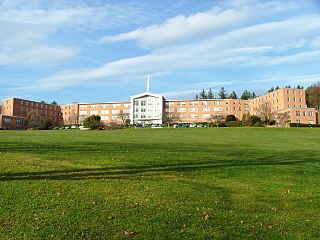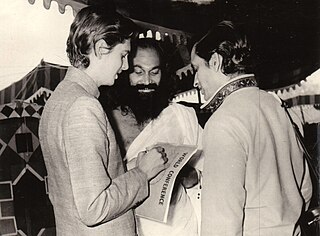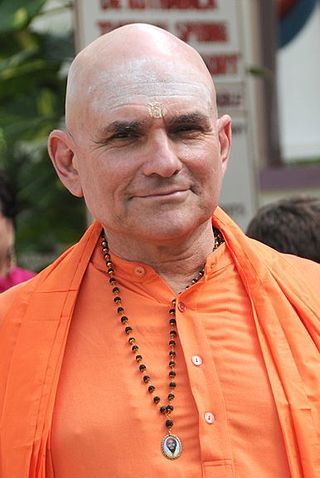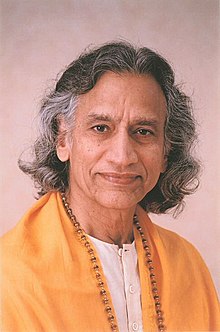
In Hinduism, Kundalini is a form of divine feminine energy believed to be located at the base of the spine, in the muladhara. It is an important concept in Śhaiva Tantra, where it is believed to be a force or power associated with the divine feminine or the formless aspect of the Goddess. This energy in the body, when cultivated and awakened through tantric practice, is believed to lead to spiritual liberation. Kuṇḍalinī is associated with Parvati or Adi Parashakti, the supreme being in Shaktism; and with the goddesses Bhairavi and Kubjika. The term, along with practices associated with it, was adopted into Hatha yoga in the 9th century. It has since then been adopted into other forms of Hinduism as well as modern spirituality and New age thought.

Kundalini yoga derives from kundalini, defined in tantra as energy that lies within the body, frequently at the navel or the base of the spine. In normative tantric systems, kundalini is considered to be dormant until it is activated and channeled upward through the central channel in a process of spiritual perfection. Other schools, such as Kashmir Shaivism, teach that there are multiple kundalini energies in different parts of the body which are active and do not require awakening. Kundalini is believed by adherents to be power associated with the divine feminine, Shakti. Kundalini yoga as a school of yoga is influenced by Shaktism and Tantra schools of Hinduism. It derives its name through a focus on awakening kundalini energy through regular practice of mantra, tantra, yantra, yoga, laya, haṭha, meditation, or even spontaneously (sahaja).

Swami Muktananda Paramahamsa, born Krishna Rai, was a yoga guru and the founder of Siddha Yoga. He was a disciple of Bhagavan Nityananda. He wrote books on the subjects of Kundalini Shakti, Vedanta, and Kashmir Shaivism, including a spiritual autobiography entitled The Play of Consciousness. In honorific style, he is often referred to as Swami Muktananda, or Baba Muktananda, or in a familiar way just Baba.

Kriya Yoga is a yoga system which consists of a number of levels of pranayama, mantra, and mudra, intended to rapidly accelerate spiritual development and engender a profound state of tranquility and God-communion. It is described by its practitioners as an ancient yoga system revived in modern times by Lahiri Mahasaya, who claimed to be initiated by a guru, Mahavatar Babaji, circa 1861 in the Himalayas. Kriya Yoga was brought to international awareness by Paramahansa Yogananda's book Autobiography of a Yogi and through Yogananda's introductions of the practice to the West from 1920.

Siddha Yoga is a spiritual path founded by Swami Muktananda (1908–1982). According to its literature, the Siddha Yoga tradition is "based mainly on eastern philosophies" and "draws many of its teachings from the Indian yogic texts of Vedanta and Kashmir Shaivism, the Bhagavad Gita and the poet-saints." The present head of Siddha Yoga is Gurumayi Chidvilasananda.

Yoga nidra or yogic sleep in modern usage is a state of consciousness between waking and sleeping, typically induced by a guided meditation.

The Kripalu Center for Yoga & Health is a nonprofit organization that operates a health and yoga retreat in Stockbridge, Massachusetts. Its 160,000-square-foot (15,000 m2) facility is a former Jesuit novitiate and juniorate seminary built in 1957.

Swami Janakananda Saraswati is a tantric yoga and meditation teacher and a writer, who has had a significant influence in the dissemination of yoga and meditation in Scandinavia and Northern Europe. He is the oldest active sannyasin disciple of Satyananda Saraswati in Europe.

Sivananda Yoga is a spiritual yoga system founded by Vishnudevananda; it includes the use of asanas but is not limited to them as in systems of yoga as exercise. He named this system, as well as the international Sivananda Yoga Vedanta Centres organization responsible for propagating its teachings, after his guru, Sivananda with the mission 'to spread the teachings of yoga and the message of world peace' which has since been refined to 'practice and teach the ancient yogic knowledge for health, peace, unity in diversity and self-realization.'

Dhirendra Brahmachari, born Dhirendra Choudhary in village Basaith Chanpura, Madhubani, Bihar, was a yoga teacher of Yogi Bhajan who taught Kundalini Yoga in the West and founded 3HO. Dhirendra Brahmachari was also yoga mentor of Indira Gandhi –The former prime minister of India He ran ashrams in Bhondsi, Jammu, Katra and Mantalai and wrote books on yoga.
Swami Vishnu Tirtha (1888–1969), also known as Munilal Swami, was a sanyas, writer, and guru with a prominent place in the Shaktipat tradition of Siddhayoga. He was born on 15 October 1888 in Jhajjar, Haryana, India. He stayed with an uncle while obtaining an undergraduate degree, then married and was employed as a teacher in Bilaspur, Chhattisgarh while he obtained a postgraduate degree and a baccalaureate in law from Aligarh Muslim University. He then practised as a lawyer in the Ghaziabad District of Meerut where his assistant was Late Chaudhary Charan Singh the former Prime Minister of India.

Mahamandaleshwar Swami Shankarananda is an American-born yoga guru in the lineage of Bhagavan Nityananda of Ganeshpuri. Swami Shankarananda is the author of several books on meditation and the philosophy and practice of Kashmir Shaivism. He emphasises spiritual practice (Sadhana), especially meditation, mantra and Self-inquiry. In Australia he founded a residential spiritual school in Australia, now called The Ashram Mount Eliza where about 20 seekers live and members of the wider public visit for programs, retreats and courses. Since 2015, there have been repeated allegations of coercive "secret sexual relations" between Shankarananda and women in the ashram community.
Swami Maheshwarananda, born Mangilal Garg, known as Swamiji, is a yogi, guru.

Kripalvananda, also known as Swami Sri Kripalvanand or Bapuji, was a renowned master of kundalini yoga and the namesake of the Kripalu Center, Kripalu Yoga style and Kripalvananda Yoga Institute, as well as a significant influence on Kriya Yoga in the United States.

Swami Nigamananda Paramahansa was an Indian yogi, guru and mystic well known in Eastern India. He is associated with the Shakta tradition and viewed as a perfect spiritual master of vedanta, tantra, yoga and prema or bhakti. His followers idealized him as their worshipped and beloved thakura.

Sivananda Radha Saraswati, born Sylvia Demitz, was a German yogini who emigrated to Canada and founded Yasodhara Ashram in British Columbia. She established a Western-based lineage in the Sivananda tradition and published books on several branches of Yoga, including Kundalini Yoga for the West and Mantras; Words of Power. She was a member of the California Institute of Transpersonal Psychology and developed transpersonal psychology workshops to help students prepare for intense spiritual practice. Teachers trained at Yasodhara Ashram can now be found across North America and in Europe, the Caribbean, Japan, Australia and New Zealand.
Integral Yoga is a system of yoga that claims to synthesize six branches of classical Yoga philosophy and practice: Hatha, Raja, Bhakti, Karma, Jnana, and Japa yoga. It was brought to the West by Swami Satchidananda, the first centre being founded in 1966. Its aim is to integrate body, mind, and spirit, using physical practices and philosophical approaches to life to develop the physical, emotional, intellectual, and spiritual aspects of individuals. The system includes the practices of asana, pranayama, and meditation to develop physical and mental stillness so as to access inner peace and joy, which Satchidananda believed was a person's true nature. It also encourages practitioners to live service-oriented lives.
Anne Cushman is an American teacher of yoga as exercise and meditation, a writer on Mindful Yoga, and a novelist. Her novel Enlightenment for Idiots was named by Booklist as one of the top ten novels of 2008. Cushman has also been an editor for Yoga Journal and Tricycle: The Buddhist Review. She directs mentoring programs and multi-year meditation training for yoga teachers at the Spirit Rock Meditation Center, emphasizing the fusion of yoga and Buddhist meditation and highlighting their shared history and philosophy.

Sexual abuse by yoga gurus is the exploitation of the position of trust occupied by a master of any branch of yoga for personal sexual pleasure. Allegations of such abuse have been made against modern yoga gurus such as Bikram Choudhury, Kausthub Desikachar, Yogi Bhajan, Amrit Desai, and K. Pattabhi Jois. There have been some criminal convictions and lawsuits for civil damages.

Modern yoga gurus are people widely acknowledged to be gurus of modern yoga in any of its forms, whether religious or not. The role implies being well-known and having a large following; in contrast to the old guru-shishya tradition, the modern guru-follower relationship is not secretive, not exclusive, and does not necessarily involve a tradition. Many such gurus, but not all, teach a form of yoga as exercise; others teach forms which are more devotional or meditational; many teach a combination. Some have been affected by scandals of various kinds.























